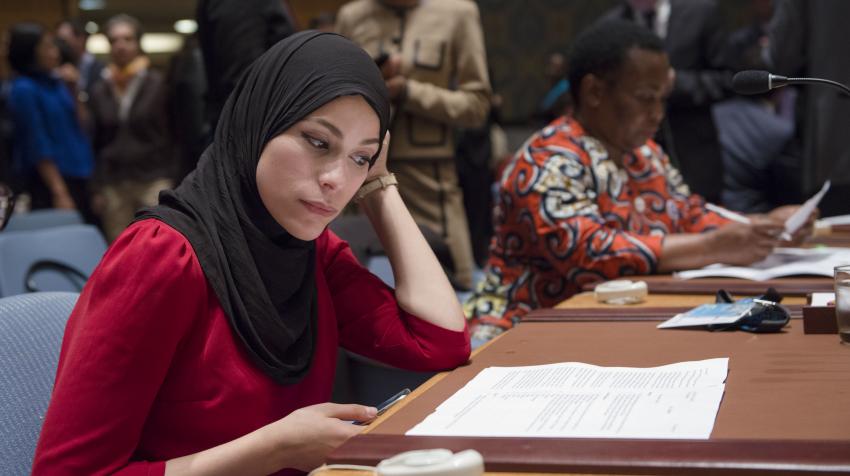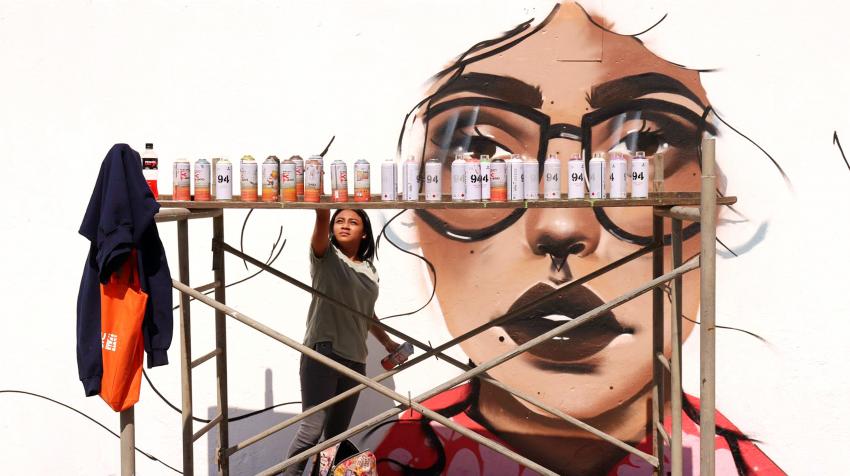Around the world, there are some 27 States where women make up less than 10 per cent of parliamentarians.[1] This dearth of representation persists despite an increase in the number of female national parliamentarians from 11.3 per cent in 1995 to the current level of 24.3 per cent.[2] While many solutions are needed to ensure more inclusive representation, what is first required is to understand why and how an egalitarian representation of women—and especially of women of colour in politics—improves society. Such an understanding could well foster greater political will and help ensure that national strategies allocate funding more appropriately.
Recent research has shown that countries in which women compose at least 30 per cent of the legislature experience a significant improvement in population health, especially mortality rates.[3] In addition to improving health, however, having more women in elected assemblies tends to reduce levels of corruption due to the creation of more inclusive policies for improving public service and by breaking up male-dominated collusive networks.[4] The inclusion of women in politics also has been linked to an increase in national gross domestic product (e.g. 5 to 10 per cent increase in the United States alone[5]), more inclusive cities[6] and greater police responsiveness in tackling crimes, especially against women and minorities.[7] Essentially, when women are equally represented in politics, they have a clear and measurable impact on health, economy, security, safety and equality, which leads to more inclusive, sustainable and democratic policies that benefit everyone. Likewise, when women are excluded from politics, everyone pays a price.
How do we get more women in politics? An immediate step is to address the insufficient legal, judicial and law enforcement means available for reducing violence and discrimination against female politicians who are already in government. In recent years, politically engaged women in many regions have been made the object of misogynistic remarks even by legislators and Heads of State, and yet the repercussions have been limited to the viral responses of social media rather than any real action to counter the effects of such hate speech. Globally, women face significantly more resistance, discrimination and abuse (both physical and reputational) within political parties and parliaments than their male counterparts.[8] Making politics safer, more meritocratic and appealing to women is crucial to ensuring their genuine participation. We can achieve this by demanding more accountability from our governments as well as the media.
It is also crucial to recognize the importance of cultivating leadership at a young age, especially in fostering the belief in young girls that they have the right—and at times even the responsibility—to occupy political space. In the United States, an equal number of girls and boys, at seven years of age, want to become President, but by the time they have reached the age of fifteen, that number has plummeted by 50 per cent for girls yet remained the same for boys.[9] Recognizing the work of female politicians and giving them visibility, however, can inspire younger generations to become politicians themselves. This is done in part through role modelling high-profile women leaders and politicians and challenging perceptions of what politicians and leaders look like. In mid-2018, the awe of two-year-old Parker Curry as she gazed at a portrait of former United States First Lady Michelle Obama sparked international interest.[10] Shortly thereafter, the buzzword “you can’t be what you can’t see” gained wide circulation as applied not only to Parker Curry but to other young women around the world as they spoke up about the women leaders whom they admired. All around the globe, women politicians were being celebrated in a unique moment.
In my work as a Sustainable Development Goals (SDG) Advocate, as the co-founder of the Emerging Leaders Taskforce and as a United Nations High-Level Commissioner on Health Employment and Economic Growth, I have seen first-hand how our experiences and opportunities in childhood shape our future realities and potential. If, from a young age, a girl or woman does not feel she has power over her own body, it can be a challenge for her to believe that she should run for public office. The denial of control over one’s own body and choices is disempowering at the most personal level and has significant public implications. The ability to exercise sexual and reproductive rights impacts the economic capacity of women (even more that of low-income women and those of colour), just as legal advances in sexual and reproductive rights positively affect the participation of women in politics.[11] The effects are circular: the more women become active in politics, the more women politicians shift governmental and legislative conversations to focus on policies that relate to reproductive rights.[12] Personal power is crucial to the engagement of women in politics—but the inverse is true as well: in countries where reproductive rights have been established and legislated, the more reproductive rights are being attacked or negated; and the more we see women joining and running for political office to defend their personal and economic power, the greater the impact on young girls today and in the future.
For all that, ensuring the participation of women in politics needs to go a step further: transforming our cultural assumptions about what traits define leadership. Stereotypically feminine traits are all too often seen as “add-ons” for leadership, whereas masculine attributes are commonly described as justification for success in leadership roles (especially by men).[13] Early in 2019, Jacinda Ardern, the Prime Minister of New Zealand, responded to a horrific terrorist attack with sympathy, love and integrity, demonstrating to us all what leadership looks like.[14] In 2015, the Argentinian legislator Victoria Donda Pérez showed how leadership and motherhood are not mutually exclusive by breastfeeding her baby while taking part in parliamentary hearings.[15] Embracing and amplifying different styles of leadership is crucial to achieving greater inclusion and representation, and it is the most efficient way to highlight and promote diversity in politics.

There is no doubt that progressive, inclusive societies are facing pushback globally and that gender equality (and the SDGs more broadly) are being challenged and in many parts of the world are even under assault. Instead of photoshopping women into political environments, what we need to be doing is protecting and promoting women’s rights by focusing on what we can actually change and bring about. We can and must ensure that young girls around the world are able to decide what to do with their own bodies. We can and must ensure that we ourselves—along with the media we digest and the communities of which we are a part—highlight and amplify the work of women leaders. Finally, we must—and we can—ensure that we change the language that we use when speaking of women’s leadership. Our focus cannot only be on present challenges, but rather making as much noise as possible in support of women’s rights and the women who are championing them daily, so that the girls of today and tomorrow can see that there is room for them in politics and it is their right—and their responsibility—to occupy that space.
Notes
[1] Inter-Parliamentary Union, “Women in national parliaments”, as at 1 February 2019. Available at http://archive.ipu.org/wmn-e/classif.htm.
[2] Ibid.
[3] Ross Macmillan, Naila Shofia and Wendy Sigle, “Gender and the Politics of Death: Female Representation, Political and Developmental Context, and Population Health in a Cross-National Panel”, Demography, Vol. 55, Issue 5, pp. 1905–1934 (October 2018). Available at https://link.springer.com/article/10.1007/s13524-018-0697-0.
[4] Monika Bauhr, Nicholas Charron and Lena Wängnerud, “Close the political gender gap to reduce corruption: How women's political agenda and risk aversion restricts corrupt behaviour”, in U4 Brief 2018:3, Anti-Corruption Resources Centre), Monica Kirya, ed. (Norway, Chr. Michelsen Institute (CMI), 2018). Available at https://www.u4.no/publications/close-the-political-gender-gap-to-reduce-....
[5] Beth Ann Bovino and Jason Gold, “The Key to Unlocking U.S. GDP Growth? Women”, (S&P Global, 2017). Available at https://www.spglobal.com/_Media/Documents/03651.00_Women_at_Work_Doc.8.5...
[6] Vera Baboun, “Creating Inclusive Cities with Gender Policies”, NewCities, 5 March 2018. Available at https://newcities.org/the-big-picture-integration-of-gender-policies-and....
[7] Lakshmi Iyer, Prachi Mishra, Anandi Mani and Petia Topalova, “The Power of Political Voice: Women’s Political Representation and Crime in India”, American Economic Journal: Applied Economics, 4(4) (2012): 165-193. Available at https://pubs.aeaweb.org/doi/pdfplus/10.1257/app.4.4.165.
[8] Leah Culhane and Jemima Olchawski, “Strategies for success: Women's experiences of selection and election in UK Parliament”, Fawcett Society (London, 2018). Available at https://www.fawcettsociety.org.uk/Handlers/Download.ashx?IDMF=b8a66d72-3....
[9] “How Many Teenage Girls Aspire To Be President Of The United States?”, The Mother List, 26 February 2014. Available at https://themotherlist.com/teenage-girls-aspire-to-be-president.
[10] Michael S. Rosenwald, “‘A moment of awe’: Photo of little girl captivated by Michelle Obama portrait goes viral”, Washington Post, 4 March 2018. Available at https://www.washingtonpost.com/local/a-moment-of-awe-photo-of-little-gir....
[11] Sandra Pepera, “Why Women in Politics?”, Women Deliver. 28 February 2018. Available at https://womendeliver.org/2018/why-women-in-politics.
[12] Sarah Kliff, “The research is clear: electing more women changes how government works”, Vox, updated 8 March 2017. Available at https://www.vox.com/2016/7/27/12266378/electing-women-congress-hillary-c....
[13] Andrea C. Vial and Jaime L. Napier, “Unnecessary Frills: Communality as a Nice (But Expendable) Trait in Leaders”, Frontiers in Psychology, 15 October 2018. Available at https://www.frontiersin.org/articles/10.3389/fpsyg.2018.01866/full.
[14] Suzanne Moore, “Jacinda Ardern is showing the world what real leadership is: sympathy, love and integrity”, The Guardian (US edition). 18 March 2019. Available at https://www.theguardian.com/commentisfree/2019/mar/18/jacinda-ardern-is-....
[15] Chris Mandle, “Argentinian politician Victoria Donda Perez praised after breastfeeding photo taken during parliamentary session goes viral”, Independent, 24 July 2015. Available at https://www.independent.co.uk/news/people/argentinian-politician-victori....
The UN Chronicle is not an official record. It is privileged to host senior United Nations officials as well as distinguished contributors from outside the United Nations system whose views are not necessarily those of the United Nations. Similarly, the boundaries and names shown, and the designations used, in maps or articles do not necessarily imply endorsement or acceptance by the United Nations.




